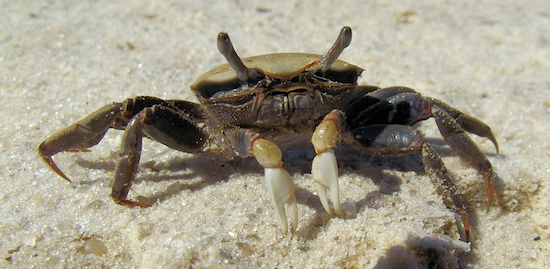| Crustaeceans and Marine Arthropods |
| Horsehoe Crab |
| Christmas Island Crab |
| Coconut Crab |
| Hermit Crab |
| Fiddler Crab |
| Alaskan King Crab |
| American Lobster |
| Rusty Crayfish |
Image Credit: https://pixabay.com/users/sheilovealways-1395942/ |
Dancing along the muddy shores of coastal estuaries and mangrove swamps are the delightful and distinctive fiddler crabs. These small crustaceans, named for the oversized, asymmetrical claws resembling a fiddle, are not only captivating in appearance but also play a crucial role in maintaining the health of their unique ecosystems.
Distinctive Anatomy: The Fiddler's Asymmetrical Serenade
The most recognizable feature of fiddler crabs is their disproportionately large claws, where one claw resembles a fiddle, while the other is significantly smaller. The larger claw, often waved in a mesmerizing display, is primarily used for attracting mates and establishing territory. This visual symphony serves as a communication tool among fiddler crabs, each one showcasing its unique claw size and rhythm.
Habitats and Distribution: Coastal Choreographers
Fiddler crabs are found in estuarine habitats across the globe, from the Atlantic and Pacific coasts to the Indian Ocean. These resilient crustaceans thrive in the intertidal zones, where the land meets the sea, creating intricate burrows in the soft mud to escape predators and regulate body temperature.
Feeding and Foraging: The Choreography of Survival
Fiddler crabs are opportunistic feeders, relying on a diet of detritus, bacteria, algae, and small organic particles. Their daily foraging activities involve sifting through the sediment with their smaller claw, collecting and consuming microscopic food particles. This feeding behavior not only sustains the fiddler crabs but also contributes to the nutrient cycling of their estuarine habitats.
Mating Rituals: A Ballet of Courtship and Reproduction
During the mating season, male fiddler crabs orchestrate intricate courtship displays to attract females. The rhythmic waving of their oversized claws, often accompanied by drumming sounds, serves as both a visual and auditory spectacle. Females select mates based on the size and vigor of these displays, leading to a harmonious union that contributes to the next generation of fiddler crabs.
Environmental Significance: Ecosystem Engineers of Coastal Realms
Fiddler crabs play a vital role in the health and sustainability of their habitats. By constructing burrows and aerating the sediment, they enhance soil structure and nutrient cycling. Additionally, their foraging activities contribute to the decomposition of organic matter, promoting the overall health of the estuarine ecosystem. As ecosystem engineers, fiddler crabs have a ripple effect on the entire coastal food web.
Conservation Considerations: Nurturing Coastal Biodiversity
While fiddler crab populations are generally stable, their habitats face threats from habitat destruction, pollution, and climate change. Conserving these coastal ecosystems is essential to safeguard the delicate balance that fiddler crabs and numerous other species contribute to. Education and responsible environmental practices are crucial steps toward preserving the biodiversity of these vital coastal realms.
